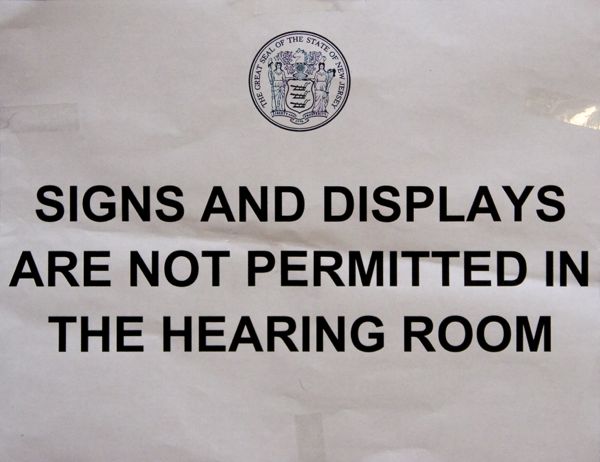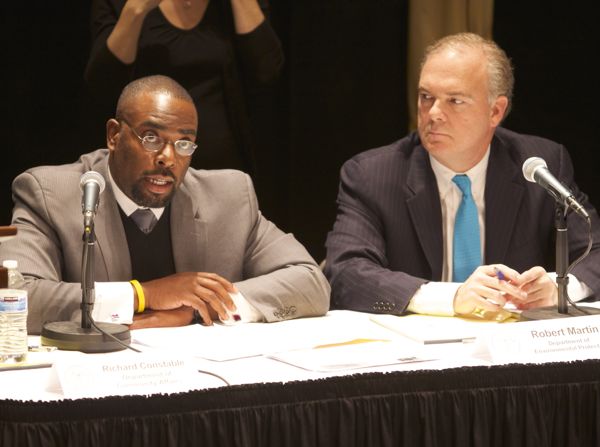Sandy Victims Blast Gov. Christie at Monmouth Public Hearing on $1.4 Billion Funding Plan
Where’s the Governor? Why is he in Washington DC instead of here listening to our problems?
Have you guys ever heard of the First Amendment? Take down those signs!
I wish the Governor were here so I could tell him exactly how I feel!
Dozens of people spoke passionately last night in Monmouth County at the final public hearing on Gov. Christie’s $1.4 billion second round HUD CDBG funding plan.
Virtually all blasted the Governor and his administration for gross mismanagement of the $1.8 billion first round in funding – many of the speakers were still homeless, living in trailers, or on the second floor of severely damaged homes.
I) Victims Tell Their Stories – Victimized Again By Christie Administration Mismanagement
Women spoke of living with children in homes with the first floor gutted, no insulation in freezing winter weather, and mold and other health hazards present.
In perhaps the most outrageous story I’ve heard so far, a disabled woman, calling herself a “jersey girl” who will not stop fighting, was denied funds (wait listed), while wealthy neighbors had received tens of thousands of HUD and FEMA dollars. So the federal aid is not only being delayed, but is not targeted to those most in need.
Not one of the Christie Cabinet members jumped up to respond to and help this woman, like they did to several others.
Again, it was shocking to hear the stories of victims, all the more disgraceful because 16 months have passed and 75% of first round $1.8 billion in federal aid has not be distributed to the people most in need.
I’ve been listening to these stories for over a year at 6 Legislative oversight hearings – all boycotted by the Christie Administration – and at the third and final public hearing on the Gov.’s $1.4 billion second round funding “Action Plan”.
II) Poorly Run Hearing – Disrespects the Public, Suppresses Dissent, and Limits Testimony
Amazingly, the format of last night’s hearing was the same as the ineffective hearing in Stockton last week.
The Christie Cabinet members – all of whom have mismanaged the process – again spoke for one hour of the 3 hour hearing.
In addition to having to listen to incomprehensible bureaucratic program summaries for a full hour, the public’s time was limited, some people could not speak, and those that did were limited to just 3 minutes.
Public testimony was again very poorly managed, as minions walked the floor with microphones as speakers’ names were called.
Don’t these people have a podium? Podiums with microphones could have been set up in front of the panel, allowing speakers to directly address Christie Cabinet officials and look them in the eye. And force the Cabinet bureaucrats to look them in the eye as well.
Instead, people were disrespected, forced to speak across the chasm of another large auditorium, and lots of time was wasted, greatly reducing the number of people who could speak – which probably was the purpose of such poorly run public hearings.
And in addition to all that, signs were posted that prohibited signs! It was obvious that the Gov. didn’t want to see any more “Christie Resign” signs in newspaper photos.

A Middletown police officer speaks to Isabel Newson of Keansburg about her "Resign Christie" sign at Gov. Chris Christie's town hall meeting at a VFW in Port Monmouth. (Tony Kurdzuk/The Star-Ledger)
III) Subject Matter Experts Ignored – Virtually Beg to Be Included
A representative of the State Association of Flood Plain Managers spoke. He highlighted their expertise and value in participating in the Sandy recovery process. He noted that the group has been shut out of the Christie Adminsitration’s policy and planning efforts and asked to be included in future efforts.
Bob Kull, a longtime NJ professional planner, spoke of the values and benefits of planning in guiding positive change. Kull offered the support professional planners in working with various local, county, and state planning efforts and he asked that planners be brought into the process.
Like the subject matter experts in flood plain management, the professional planning community has been cut out of the Adminsitration’s “planning” efforts. As I’ve written, that is because this administration is actively hostile to planning.
IV) Fatal Failures to Prepare and to Plan
I got my 3 minute chance to speak a little over 2 hours into the hearing.
I was again interrupted by Mark Ferzan, Christie’s Sandy Czar and the guy running the hearing, and just at the moment I was making an important point. I now think that this interruption was no accident, but an intentional tactic to divert and derail my testimony.
I made 2 main points: failure to prepare for the storm and failure to plan a recovery.
I explained how NJ Transit was once at the forefront and part of a national pilot program to develop climate change vulnerability assessment and adaptation plans for transportation infrastructure.
But, because Gov. Christie was virtually a climate change denier – ignoring the NJ Global Warming Response Act, slashing a host of climate change related programs, rolling back renewable energy programs, and diverting $1 billion of clean energy money – NJ Transit Director Weinstein could not present the climate adaptation pilot study to the Gov. and request funds to begin tackling the necessary planning and investment work.
As a result of Gov. Christie’s policy of denial, Weinstein ignored multiple warnings and NJ Transit had no plan. Thus NJT was unprepared, and suffered a completely avoidable $120 million loss of almost a third of their rolling stock.
As I’ve written, responding to the same policy direction from the Gov.’s Office, similar failures occurred at DEP, where climate change, vulnerability assessment, and coastal management programs were eliminated, scaled back, or defunded. Experienced DEP program managers were sent to DEP’s Bureaucratic Siberia or purged and forced out of the DEP.
For those interested in the substance of all that, see:.
The Huffington Post did a great investigative report of what went wrong, see: Jersey Shore Development Failures Exposed By Hurricane Sandy
V) Failure to Consider Climate Change and Sea Level rise
As I’ve written here multiple times, the Christie Administration’s “Action plan” does not consider climate change and the single paragraph that does mention sea level rise provides no mechanisms to implement the science in federally funded state programs and funded projects, as required by new HUD regulations.
This failure to base funding decisions on science extends to the failure to provide transparent, objective and enforceable criteria and standards for the residential buyout program or the purchase of highly vulnerable or environmentally sensitive areas. This invites political intervention and abuse.
Technical flaws also include failure to update DEP’s flood hazard maps – there are thousands of NJ homes and businesses in flood plains that do not know it and people dare rebuilding below known future flood elevations. Therefore have not purchased flood insurance. These people will be wiped out emotionally and financially when the next storm hits.
VI) Failure to make sufficiently detailed and binding commitments
With one exception (i.e the DEP emergency rules that prematurely adopted the FEMA Advisory Base Flood Elevations), the Christie “Action Plan” makes a bunch of vague and prospective promises.
The plan lacks detailed initiatives and enforceable commitments.
For example, NJ has a host of plans, programs, and regulations that could form the foundation, technical basis, and planning process to guide Sandy recovery, including
- the NJ State Development and Redevelopment Plan
- a federally approved Coastal Zone Management Program
- a coastal land use planning law (CAFRA) and implementing regulations
- wastewater infrastructure planning program
- water supply infrastructure planning program
- flood hazard regulations
ALL THESE NJ STATE PROGRAMS WERE IGNORED IN GOVERNOR CHRISTIE’s PLAN.
HUD must either reject Gov. Christie’s funding plan as deficient and not in compliance with HUD rules and President Obama’s Executive Order, or condition its approval of requirements that NJ and DEP strengthen and deploy the above State tools to manage Sandy recovery and federal funding.










